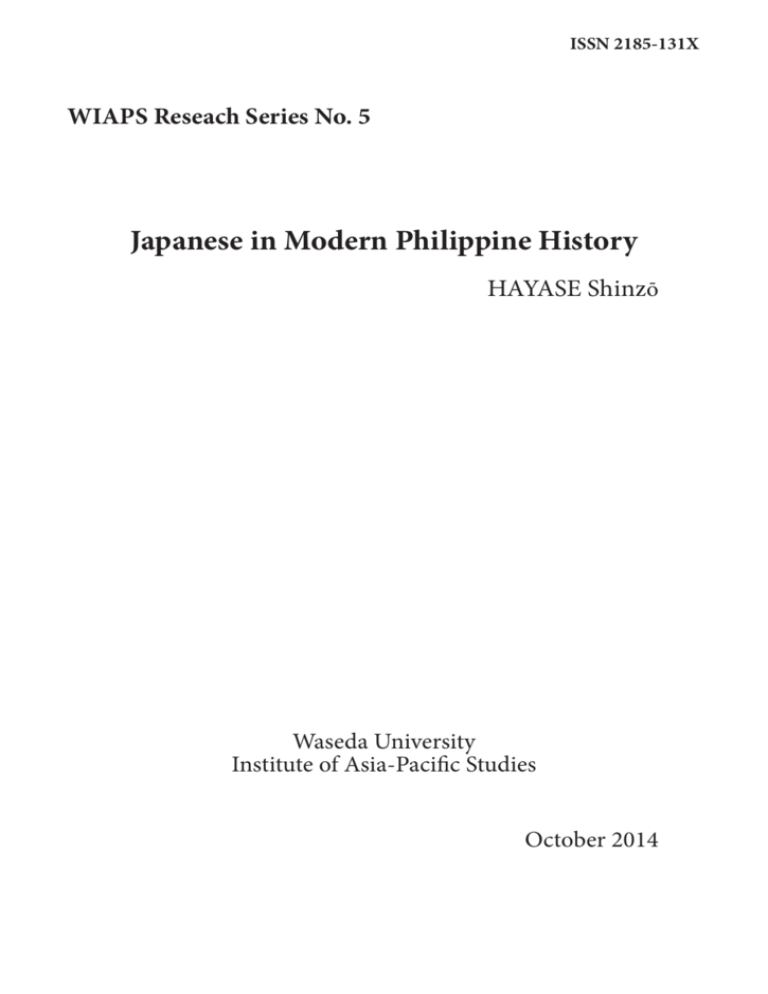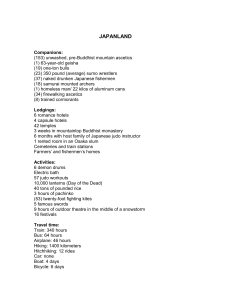
ISSN 2185-131X
WIAPS Reseach Series No. 5
Japanese in Modern Philippine History
HAYASE Shinzō
Waseda University
Institute of Asia-Pacific Studies
October 2014
̶ 1 ̶
WIAPS Research Series No. 5
Japanese in Modern Philippine History
by HAYASE Shinzō
Publidshed by Waseda University, Institute of Asia-Pacific Studies
©2014 HAYASE Shinzō
October 2014
All rights reserved.
No part of this book may be used or reproduced in any manner of form without
written permission by the author, except in the form of brief quotations embodied
in critical articles or reviews.
Published by
Waseda University, Institute of Asia-Pacific Studuies
Sodai-Nishiwaseda Bldg. 7F
1‒21‒1 Nishiwaseda
Shinjuku-ku, Tokyo 169‒0051, JAPAN
Printed and bound by International Academic Publishing Co., Ltd.
3‒8‒8 Takadanobaba
Shinjuku-ku, Tokyo 169‒0075, JAPAN
̶ 2 ̶
Contents
Introduction
1
Seeing the World and Japan from the Philippines
History of the Study of Modern and Contemporary Philippines‒Japan Relations
Beyond Modern Written Historiography
I. Japanese Immigrants in the Philippines
Chapter 1 An Overview of Japanese in the Prewar Philippines
̶Emigrants, Diplomats and Military Activities
10
1. Japanese Prostitutes:“Karayuki-san”
2. Japanese Construction Laborers on Benguet Road
3. Japanese Planters and Laborers in Davao
4. Japanese Fishermen
5. Japanese Commercial Activities
6. Japanese Diplomats in Manila
7. Military Activities
Chapter 2 Diplomats of Meiji Japan in the Philippines
24
1. Japan’
s Push Factor
2. Philippines’
Pull Factor
3. Japanese Laborers
4. The Reports of Japanese Diplomats in Manila
5. Japanese Diplomats and Japanese Expansion
Chapter 3 Japanese Fishermen in Manila Bay during the Meiji Period
(1868‒1912)
40
Introduction
1. Fishermen in the Lists of Overseas Travelers to the Philippines
2. Japanese Fishermen in the Philippines Classified by Occupations
3. Four Stone Monuments in Hiroshima Prefecture
4. Fishing Activities by Japanese Fishermen in Manila Bay
5. Philippine Fishery
Concluding Remarks
̶ i ̶
II. Japanese Goods in the Philippines
Chapter 4 Japanese Goods under the U.S.‒Philippine Free-Trade System
60
Introduction
1. The Structure of Japan, U.S., and Philippine Trade in Asia
(1) The Characteristic Features of Japan’
s Asian Trade
(2) The Characteristic Features of U.S.‒Asian Trade
(3) Asian Trade in U.S.‒Japanese Relations
(4) The Characteristic Features of Philippine Foreign Trade
2. Japanese Products and Their Dealers
(1) Japanese-Made Goods
(2) Japanese Goods Dealers
(3) The Japanese Consulate
Concluding Remarks
Chapter 5 A Study of Modern Popular Consumer Society̶The Japanese
Bazaars and Merchandise in the American-Occupied Philippines
86
Introduction
1. The Formation of a Popular Consumer Society
(1) American Culture and the Capital of Manila
(2) Dissemination of Education and Mass Media
(3) Development of the Transportation Network
2. Merchants in Rural Commerce
(1) The Chinese
(2) The Japanese
3. The Penetration of Japanese Merchandise into Filipino Society
(1) The Causes of Increase and Decrease in the Import of Japanese Merchandise
(2) The Influence of Japanese Merchandise on Philippine Society
Concluding Remarks
III. Japanese and the War in the Philippines
Chapter 6 The Philippine Society of Japan and The Philippine Information Bulletin
Introduction
1. The Philippine Society of Japan or Firipin Kyōkai
2. The Philippine Information Bulletin or Firipin Jōhō
Concluding Remarks
̶ ii ̶
122
Chapter 7 The Japanese Residents of“Dabao-kuo”
144
Introduction
1. Japanese Emigrants and Colonists to the Philippines
(1) The Overall Plan
(2) The Origins of the“Dabao-kuo”
2. Davao Japanese Residents’
Cooperation in the War
(1) “Place of Death”
(2) The Invasion of Davao and the Japanese Community
(3) Resident Japanese as“Models of Deportment for the People of the Philippines”
(4) Monetary Donations
(5) Volunteer Labor
(6) Increasing Food Production
(7) The Evaluation of the Davao Japanese
3. The Image of Japanese Held by Filipinos in Davao
(1) War Crimes in Davao
(2) Killings Soon after the Beginning of the War
(3) Killings by the Military Police
(4) Killings in the Midst of Flight
(5) Role Played by the Davao Japanese
Concluding Remarks
Appendix “Japanese War Crime Records
̶Closed Reports”in the Philippine National Archives
Chapter 8 Publications of War Memoirs as Paper Cenotaphs̶Mass Death
and the Defeat: The Meaning of Writing War Memoirs
Introduction
1. Memorializing the War Dead in Modern Japan
2. Publication of War Memoirs on the Philippines
(1) Publication Date
(2) Age of Author
(3) Index of Personal Names, Places, and Subjects
3. Analysis of War Memoir: The Moonlit Road by MARUYAMA Yutaka
Concluding Remarks
̶ iii ̶
182
Conclusion
205
The Japanese in the Philippines during the Modern Era
Lack of Philippines‒Japan Cultural Exchange
Bibliography
212
Index
233
̶ iv ̶
Lists of Tables
1‒1.
Japanese Population in the Philippines, 1889‒1943
2‒1.
Arrived and Departed, and Immigrated and Emigrated Japanese to/from
the Philippines, 1898‒1912
2‒2.
Japanese Populations in the Philippines, 1889‒1912
2‒3(1). Number of Japanese Emigrants to the Philippines, 1901‒12
2‒3(2). Japanese Emigrants to the Philippines, 1901‒12 by Prefecture
2‒3(3). Japanese Emigrants to the Philippines, 1901‒12 by Age
2‒3(4). Japanese Emigrants to the Philippines, 1901‒12by Sex
2‒4.
Diseases and Deaths on the Benguet Road, October 1, 1903‒August 31,
1904
2‒5.
Average Daily Number of Employees on the Benguet Road Construction,
January 1901‒August 1904
4‒1.
Destinations for Philippine Trade Tonnage in 1934: Imports
4‒2.
Destinations for Philippine Trade Tonnage in 1934: Exports
4‒3.
Number of Retailing and Wholesaling Establishments According to the
Nationality of Their Owners
4‒4.
Grocery and“Sarisari”Stores According to the Nationality of Their Owners, December 31, 1938
5‒1.
Free and Dutiable Merchandise Imported in 1940(Pesos)
5‒2.
Annual Enrollment by Grades, School Year 1918‒19 and 1939‒40
5‒3.
Number of Literate Persons in 1939
5‒4.
Newspapers and Other Publications(Entered in the Bureau of Posts as
Second-Class Mail Matter)
5‒5.
Number and Net Tonnage of Coastwise Vessels Entered into, and Cleared
from, Philippine Ports
5‒6.
Estimated Commercial Investment by Nationality(Pesos, at the End of
Fiscal Year 1937)
5‒7.
Population by Nationality in Census 1918 and Census 1939
5‒8.
Commercial Investment by Nationality and Province(Pesos), and Chinese
and Japanese Populations
5‒9.
Prices of Japanese Products and American Products
̶ v ̶
List of Figures
4‒1.
World Trade by Ports―Export(1,000,000 Yen)
4‒2.
World Trade by Ports―Import(1,000,000 Yen)
4‒3.
World Trade by Ports―Export(%)
4‒4.
World Trade by Ports―Import(%)
4‒5.
Asian Trade by Ports―Export(%)
4‒6.
Asian Trade by Ports―Import(%)
4‒7.
Philippine Trade by Ports―Export(%)
4‒8.
Philippine Trade by Ports―Import(%)
4‒9.
U.S. Asian Trade―Export(%)
4‒10. U.S. Asian Trade―Import(%)
4‒11. U.S. Trade by Ports―Export(%)
4‒12. U.S. Trade by Ports―Import(%)
4‒13. Import and Export Values in Manila(%)
4‒14. Japanese Commercial Population in the Philippines, 1927‒38
5‒1.
Philippine Trade, 1898‒1940(1,000,000 Pesos)
5‒2.
Philippine Imports, 1898‒1940(%)
5‒3.
Total Length of Roads(km)and Total of Vehicles, 1912‒38
5‒4.
Numbers of Registered Vehicles, 1912‒38
5‒5.
Japanese Commercial Population in the Philippines, 1927‒38
5‒6.
Japanese Commercial Population in the Philippines, 1927‒38―Merchants,
Male Occupation
5‒7.
Japanese Commercial Population in the Philippines, 1927‒38―Office Workers,
etc., Male Occupation
5‒8.
Japanese Commercial Population in the Philippines, 1927‒38―Merchants,
Total of Family Members
5‒9.
Japanese Commercial Population in the Philippines, 1927‒38―Office Workers,
etc., Total of Family Members
8‒1.
Number of“Publications of War Memoirs”by Five Years
8‒2.
Number of Authors by Years of Birth(Every Five Years)
Acknowledgments
I am indebted to Dr. Motoe Terami-Wada and her friends, William Bradley
Horton, and Graeme Parker for translating a part of this book into English and/or
proofreading it.
̶ vi ̶
Map: Commonwealth of the Philippines
Source: Joseph Ralston Hayden, The Philippines: A Study in National Development.
New York: The Macmillan Company, 1942.
̶ vii ̶
Dedicated to the Memory of Grant K. Goodman (1924‒2014)
and Lydia N. Yu-Jose (1944‒2014)
̶ viii ̶










